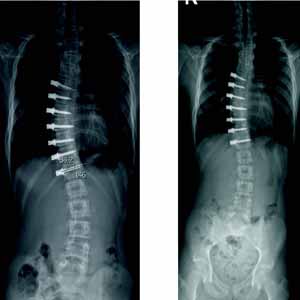Anterior vertebral body tethering as a treatment for scoliosis in skeletally immature patients

All claims expressed in this article are solely those of the authors and do not necessarily represent those of their affiliated organizations, or those of the publisher, the editors and the reviewers. Any product that may be evaluated in this article or claim that may be made by its manufacturer is not guaranteed or endorsed by the publisher.
Authors
A relatively new surgical procedure called Anterior Vertebral Body Tethering (AVBT) is used to treat scoliosis in patients with immature skeletons. It is a growth modulation fusionless system that Crowford and Lenke first described in 2010. We present our observations from 25 patients. Improvement in the mean coronal Cobb angle, from mean 57° preoperative to mean 34° postoperative, was 40%. Additionally, we noted that the mean thoracic hypokyphosis improved from 16° to 24° on average after surgery. Complication rates were 16% and surgical revision rates were 12%. All patients who demonstrated improvement in pain, function, and self-image underwent administration of the SRS-24 questionnaire. These data, according to the literature, show that AVBT is a reliable technique that enables scoliosis correction in skeletally immature patients and maintains that correction while utilizing remaining growth potential to achieve further correction, avoiding spinal fusion, and maintaining spine mobility.
How to Cite

This work is licensed under a Creative Commons Attribution-NonCommercial 4.0 International License.
PAGEPress has chosen to apply the Creative Commons Attribution NonCommercial 4.0 International License (CC BY-NC 4.0) to all manuscripts to be published.






